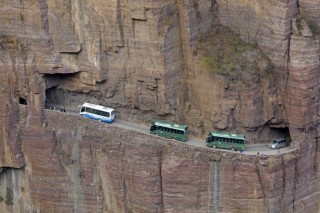Flowing Water Erosion
Fluvial erosion, the process by which water physically weathers and chemically erodes surface rocks, plays a significant role in shaping various landforms over extended periods of time.
1. Canyon Landforms
Canyons are long and narrow terrains formed as a result of water flowing deeply across the surface.
They typically require rivers with substantial water flow and steep gradients, which exert strong impacts and abrasion on the surrounding rocks. Canyons serve as indicators of the intensity of water erosion and represent different stages in the development of landforms.
2. Waterfall Landforms
Waterfall landforms are characterized by the dramatic vertical or slanting drops created by water flow within a river channel.
Examples include the renowned Yellowstone Falls and Phoenix Falls in the South Ridge. The formation of waterfalls depends on favorable geological conditions and significant differences in elevation, showcasing the erosive power of water on rocks. Observing waterfalls allows us to witness the dynamic processes of geomorphic evolution.
3. River Valley Landforms
River valleys are relatively low-lying areas formed by continuous water erosion on both sides of a river. Yu Yuan Tan river valley is an example of such a landform.
River valleys develop over long periods through stable water flow erosion, and changes in their width and depth reflect variations in water flow energy. These landforms provide valuable insights into the historical trajectory of landform development.
4. Channel Valley Landforms
Channel valleys are elongated and narrow terrains eroded by water along fractures in rock layers or areas with softer rock compositions.
In some cases, the presence of underground water veins can give rise to underground rivers within these valleys. The formation of channel valleys is influenced by the presence of more water-soluble rocks, and their creation demonstrates the interplay between water erosion and geological processes.
5. Terraced Landforms
Terraced landforms are characterized by a series of flat, horizontal platforms or steps carved into slopes by the erosive action of water.
These terraces often form in regions with alternating layers of resistant and easily erodible rocks. Over time, water flowing down the slopes gradually erodes the softer layers, leaving behind stepped formations.
Terraced landforms can be found in various parts of the world, such as the rice terraces in Southeast Asia and the agricultural terraces in the Andes Mountains. They not only showcase the impact of water erosion but also provide fertile ground for agricultural practices.
6. River Floodplains
River floodplains are broad, flat areas adjacent to rivers that experience periodic flooding. These floodplains are created through the deposition of sediment carried by the river during flood events.
The repeated cycles of flooding and sediment deposition contribute to the gradual expansion and shaping of the floodplain. River floodplains are essential for supporting diverse ecosystems, as the nutrient-rich sediments deposited during floods promote fertile soil and provide a habitat for various plant and animal species.
Fluvial erosion and the resulting landforms are not only awe-inspiring but also vital for the Earth's ecological balance.
These landforms provide habitats for countless organisms, act as natural water storage systems, and contribute to the overall functioning of watersheds. Furthermore, they serve as geological records, preserving evidence of past environmental changes and the evolution of landscapes.
Understanding fluvial erosion and its impact on landforms is crucial for land management, conservation efforts, and sustainable development.
It enables us to make informed decisions regarding the protection of vulnerable areas, the preservation of natural landscapes, and the mitigation of potential hazards associated with water erosion, such as flash floods and landslides.
Fluvial erosion shapes a diverse range of landforms through the physical and chemical actions of water over long periods. From canyons to waterfalls, river valleys to channel valleys, these landforms illustrate the transformative power of water and provide a glimpse into the Earth's geological history.
Appreciating and studying these landforms not only deepens our understanding of Earth processes but also fosters a greater appreciation for the beauty and interconnectedness of the natural world. By recognizing the importance of fluvial erosion, we can strive to protect and preserve these remarkable landscapes for future generations to admire and enjoy.
You may like:


